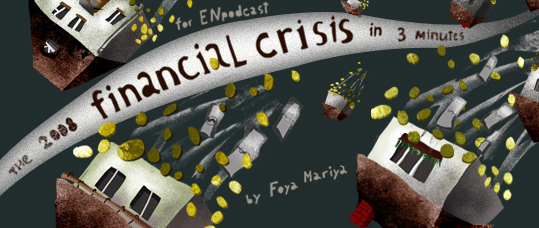The 2008 Financial Crisis In 3 Minutes
As many of you know, in 2007-2008 the world experienced the biggest financial crisis since The Great Depression of the 1930s. This crisis, also known as Global Financial Crisis or The Meltdown, originated in the USA, yet managed to trigger a worldwide chain reaction. All across the globe, from London to Beijing, from Moscow to Brazil, markets were falling, and the future recovery prospects were dim. Yet not many know what truly brought about this mass meltdown. In this podcast, we will try to find out exactly that.
The roots of the crisis can be traced down to late 2005, when the housing prices in the US reached an enormous level. This means that houses became a lot more expensive than their true worth. The situation itself was a result of lax lending standards, when banks were willing to give a mortgage to anyone, regardless of their income. Such a practice resulted in millions of people buying big houses and flats, which they could not have been able to afford without a generous mortgage from the banks. Moreover, as people saw the value of their houses going up, many chose to remortgage their houses, meaning they borrowed more money from the banks, using their house as collateral.
Meanwhile, investment banks came up with a new financial product – collateral debt obligations (or CDOs). In simple terms, this product consisted of a big number of people's mortgages and car loans, and provided steady cash flows to the investor that bought it. This business practice proved to be so profitable for the bankers that they were only too willing to give out more and more loans to people. Yet the fact that the loans were given to people who couldn't pay them back was not the only problem. Unfortunately, the abovementioned CDOs were made up of a mix of different loans and then sold to investors around the world. The practice of spreading this financial product around the world is exactly what made so many countries suffer from what originally should have been a US-only crisis.
This lending and selling could have gone like this for a very long time, but in late 2006 house prices started to decline. This meant that the market price of a family's house was now less than what they were paying to the bank in monthly mortgage payments. Tragically, falling house prices meant a slowdown in the economy as a whole, and thus many people started losing their jobs. As a result, they were now unable to keep up with their mortgage payments and the big number of them lost their homes.
While this was happening, banks saw their CDOs losing value as people stopped paying the mortgage fees, and investors started selling the CDOs they had previously bought. This triggered panic in the markets: investors were selling, yet nobody wanted to buy, which meant that investment banks were left with worthless products and massive debts.
Luckily, the US Federal Reserve System decided to bailout the affected banks, so banks got additional money from the government. Yet even though it did save the financial system from collapse, it showed how connected and vulnerable the current world of finance is.
I hope this gave you the basic understanding of the situation, but if you truly want to get to the bottom of it, check the Internet for details.
Vocabulary:
- trigger
- dim
- brought about
- be traced down
- lax
- mortgage
- remortgage
- collateral
- came up with
- cash flow
- were only too willing
- keep up with
- bailout
- get to the bottom of
















